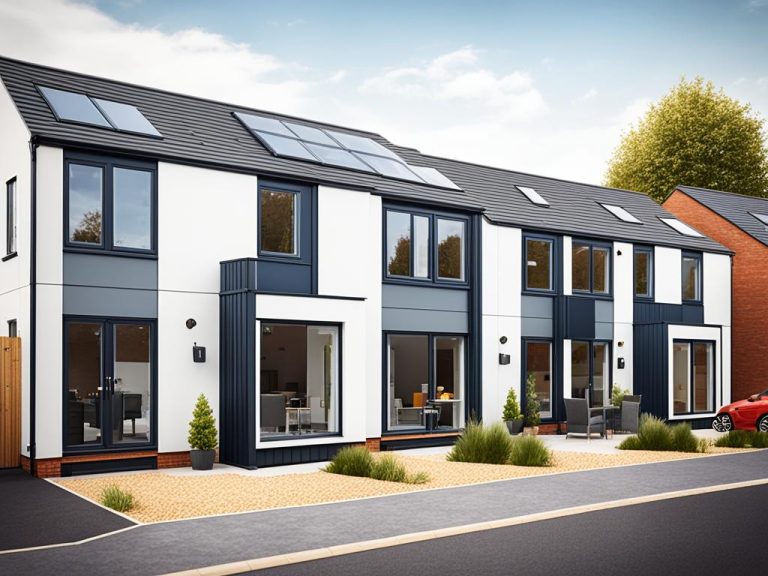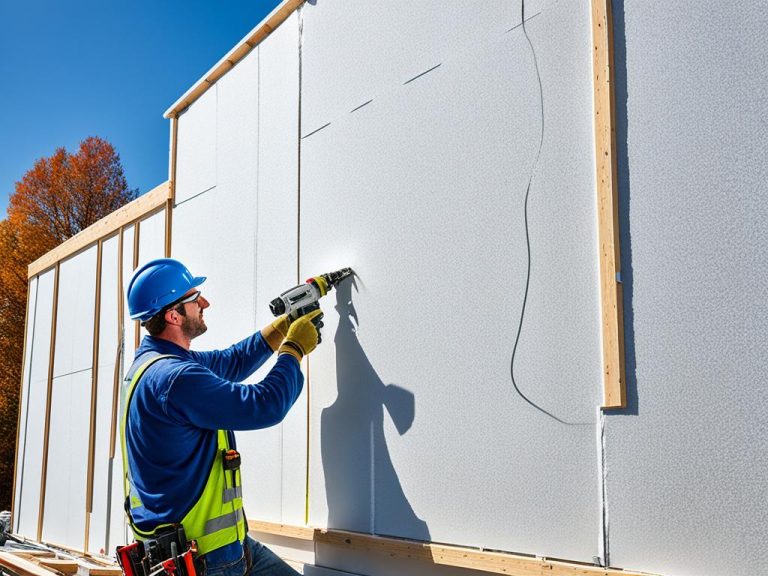Can you put a modular home on your parents’ land? US vs UK rules

When it comes to placing a modular home on your parents’ property, there are certain rules and regulations to consider in both the United States and the United Kingdom. It’s important to understand the housing regulations, zoning laws, and property ownership guidelines that apply in your specific country. Additionally, building permits and building codes play a crucial role in determining the feasibility of constructing a modular home on your parents’ land. Let’s explore the housing options and legal requirements in the UK for placing a modular home on your parents’ property.
Key Takeaways:
- In the UK, specific laws govern the road legality, planning permission, and council tax associated with placing a modular home on your parents’ land.
- Understanding the size and weight limitations for road legality is essential to ensure your modular home meets the necessary requirements.
- Placing a modular home in your parents’ garden usually does not require planning permission, but it’s important to check with local planning authorities to ensure compliance.
- Various options are available for placing your modular home in the UK, including within the curtilage of your home, on a plot of land, or on caravan and glamping sites.
- Whether or not you need to pay council tax depends on the usage and location of your modular home, as well as your primary residence.
Road Legality in your Tiny Home
To ensure your tiny home is road legal in the UK, it must meet certain requirements. It should be no wider than 2.55m and no longer than 7m if being towed on a standard car license. If you plan on having a larger home, you may need to obtain a C1E license. The weight you can tow on the road depends on when you passed your driving test.
Key Requirements
- The maximum width of the tiny home should not exceed 2.55m.
- The length of the tiny home while being towed should be no more than 7m.
- If your tiny home exceeds these dimensions, you may need to obtain a C1E license.
- The weight you can tow depends on when you passed your driving test.
If you want to ensure your tiny home adheres to road legality standards in the UK, it is essential to keep these requirements in mind. By doing so, you can enjoy peace of mind while traveling with your tiny home and avoid potential legal issues.

Planning Laws & Planning Permission for Tiny Houses UK
In the UK, placing a tiny house in your back garden usually does not require planning permission, as long as it meets certain size limitations and is used as additional living space. This falls under the permitted development rights, which allow you to make specific types of improvements to your property without seeking formal permission.
However, if you plan to purchase or rent land for your tiny house and it will be a permanent fixture, you may need to obtain planning permission. This is especially relevant if you intend to use the tiny house as a separate and independent dwelling.
It is important to check with your local planning office for the specific regulations and requirements in your area. They will be able to provide guidance on whether planning permission is needed and any restrictions that apply. It is recommended to seek written confirmation of any approvals you receive to avoid potential issues in the future.
Having a clear understanding of planning laws and obtaining the necessary permissions is crucial to ensure that your tiny house project complies with regulations while avoiding any potential legal complications. Remember to consider factors such as the size and location of your tiny house, as well as the intended use, to determine the appropriate course of action.
By staying informed and seeking professional advice when necessary, you can navigate the planning process and enjoy the benefits of having a tiny house in the UK.
Where can I put my Tiny House in the UK?
If you’re considering a tiny house in the UK, you have several options for placement. Depending on your preferences and circumstances, you can choose to position your tiny house in various locations:
- Within the curtilage of your home, such as in your garden. This allows for convenient access to your existing property and utilities.
- On a plot of land, whether you have planning permission or not. This option provides the flexibility to create a dedicated space for your tiny house.
- On a caravan or park home site. These sites often offer amenities and communal facilities, providing a sense of community.
- On a glamping site, where you can combine the benefits of tiny house living with a unique vacation experience.
- On a certified site specifically designated for tiny houses. These sites ensure that the necessary infrastructure and regulations are in place for safe and legal placement.
- On farmland or stables, if you’re looking for a more rural setting. This option offers a picturesque and tranquil environment.
It’s important to note that the regulations and requirements for each placement option may vary. Be sure to research and comply with any applicable rules to ensure a seamless and legal placement of your tiny house.

Council Tax – Do you need to pay?
Whether or not you need to pay council tax for your tiny house depends on how it is used and where it is located. If you are renting or purchasing land for your tiny house and it will be your permanent residence, you will likely be required to pay council tax. However, if the tiny house is used as a holiday home or secondary dwelling and you have a full-time residence elsewhere, council tax may not be required.
It’s important to note that if the tiny house is located in your back garden and used as additional living space by members of your household, council tax may not apply.
If you want to learn more about the regulations and requirements around council tax for your tiny house, it is advisable to consult with your local council or tax authority for specific guidance.
Factors affecting council tax for your tiny house:
- The intended use of your tiny house (permanent residence, holiday home, or secondary dwelling)
- The location of your tiny house (back garden, rented land, etc.)
- Whether you have a full-time residence elsewhere
- If it is used as additional living space by members of your household
Understanding the council tax regulations and requirements for your tiny house is important to ensure compliance with local laws and regulations. By familiarizing yourself with the specific rules that apply to your situation, you can avoid any potential issues and enjoy your tiny house with peace of mind.

Are Tiny Houses Legal in the U.K?
Tiny houses are becoming increasingly popular as an alternative housing option in the U.K. But are they legal? The good news is that tiny houses are considered caravans in the eyes of the law and are, therefore, legal to own and live in. However, it is important to understand the legal definition of a caravan and the regulations surrounding its use and placement.
When it comes to tiny houses, the legal definition of a caravan is crucial. A caravan is defined as a structure that is transportable, designed for human habitation, and provides sleeping accommodation. As long as your tiny house meets these criteria, you can rest assured that it is legally recognized.
However, the legality of placement and occupation of a tiny house depends on various factors. If your tiny house is intended to be used as a separate and independent dwelling, you may need to obtain planning permission. Planning permission is required for permanent dwellings and ensures that the property meets certain standards and regulations.
If you plan on using your tiny house as a granny annexe or ancillary building, where it is an extension of an existing dwelling, you may not need planning permission. An ancillary building is typically used for additional living space or to accommodate an elderly family member. In these cases, it is important to consult with your local planning authority to confirm whether planning permission is required.
It is worth noting that a tiny house is a compact house that can be transported and placed on various types of land. You may choose to place your tiny house in your garden, on a plot of land, or even on a caravan or park home site. Each option has its own set of regulations, so it is essential to research and comply with any applicable rules.
When it comes to planning permission, it is always a good idea to seek advice from your local planning authority. They can provide detailed information on the specific requirements and regulations that apply to your situation. Consulting with the experts will ensure that you are aware of any legal obligations and can proceed with confidence.
Legal Definitions

Summary
Tiny houses are indeed legal in the U.K. as long as they meet the legal definition of a caravan. However, the specific regulations regarding use and placement vary depending on the intended purpose of the tiny house. Whether you are planning to use it as a compact dwelling or an ancillary building, it is important to be familiar with the relevant planning laws and seek the necessary permissions. By doing so, you can enjoy the benefits of tiny house living while complying with all legal requirements.
Use of a mobile home in the garden of a residential house
When considering the placement of a mobile home in the garden of a residential house in the United Kingdom, you may be wondering about the planning permission requirements. The good news is that, in most cases, you do not typically require planning permission for this type of arrangement. However, it is advisable to obtain a Certificate of Lawfulness from the planning authorities to ensure compliance with the regulations.
The Certificate of Lawfulness confirms that the placement of the mobile home does not involve any development or change of use of the land. This documentation provides assurance that you are within the legal boundaries of land usage. While obtaining this certificate is not mandatory, it can offer peace of mind and protect against potential future legal issues.
It is important to note that there are specific guidelines and rules that need to be followed when placing a mobile home in your garden. To obtain detailed information on how to proceed with the installation of a mobile home, it is recommended to refer to the Mobile Homes in Gardens planning guide. This guide provides valuable insights into the regulations, requirements, and best practices for setting up a mobile home in your garden.

By following the guidance provided in the Mobile Homes in Gardens planning guide and obtaining the necessary Certificate of Lawfulness, you can confidently proceed with the installation of a mobile home in your garden as a convenient and flexible living option for you and your family.
Conclusion
When it comes to placing a modular home on your parents’ property in the UK, it’s essential to navigate the specific regulations to ensure legality and compliance. From road legality to planning permission and council tax, there are factors to consider to enjoy the benefits of a modular home on your parents’ property while adhering to the law.
To begin, ensure that your modular home meets the size and weight requirements for road legality. This includes adhering to the maximum width of 2.55m and length of 7m if being towed on a standard car license. If your modular home exceeds these dimensions, you may need to obtain a C1E license.
Next, consider the planning laws and regulations for placing your modular home. While placing a tiny house in your back garden usually doesn’t require planning permission, if you plan to purchase or rent land, it’s important to check with your local planning office for any necessary permissions. Additionally, be aware that council tax may apply depending on the use and location of your modular home.
In summary, by understanding the UK regulations surrounding road legality, planning permission, and council tax, you can enjoy the benefits of placing a modular home on your parents’ property. It’s crucial to ensure compliance with size and weight requirements, obtain necessary permits or permissions, and be aware of any applicable council tax obligations.
FAQ
Can you put a modular home on your parents land? US vs UK rules
The legality of placing a modular home on your parents’ property is subject to certain rules and regulations in both the US and the UK. However, in the UK, there are specific laws regarding road legality, planning permission, council tax, and where you can place your modular home.
Road Legality in your Tiny Home
To ensure your tiny home is road legal in the UK, it must meet certain requirements. It should be no wider than 2.55m and no longer than 7m if being towed on a standard car license. If you plan on having a larger home, you may need to obtain a C1E license. The weight you can tow on the road depends on when you passed your driving test.
Planning Laws & Planning Permission for Tiny Houses UK
In the UK, placing a tiny house in your back garden usually does not require planning permission, as long as it meets certain size limitations and is used as additional living space. However, if you plan to purchase or rent land for your tiny house, you may need to obtain planning permission if it will be a permanent fixture. It is important to check with your local planning office for specific requirements and to get written confirmation of any approvals.
Where can I put my Tiny House in the UK?
You have several options for placing your tiny house in the UK. These include within the curtilage of your home (such as in the garden), on a plot of land (with or without planning permission), on a caravan or park home site, on a glamping site, on a certified site, or on farmland or stables. The specific regulations and requirements may vary depending on the location, so it is important to do your research and comply with any applicable rules.
Council Tax – Do you need to pay?
Whether or not you need to pay council tax for your tiny house depends on how it is used and where it is located. If you are renting or purchasing land for your tiny house and it will be your permanent residence, you will likely be required to pay council tax. However, if the tiny house is used as a holiday home or secondary dwelling and you have a full-time residence elsewhere, council tax may not be required. It’s important to note that if the tiny house is located in your back garden and used as additional living space by members of your household, council tax may not apply.
Are tiny houses legal in the UK?
Tiny houses are legal in the UK, as they are considered caravans in the eyes of the law. However, the legality of placement and occupation depends on various factors. It is crucial to ensure that your tiny house meets the legal definition of a caravan and to comply with any regulations regarding use and placement. For example, if the tiny house is used as a separate and independent dwelling, planning permission may be required. It is recommended to seek advice from your local planning authority to clarify any legal requirements.
Use of a mobile home in the garden of a residential house
Placing a mobile home in the garden of a residential house does not typically require planning permission, but it is advisable to obtain a Certificate of Lawfulness from the planning authorities. This certificate confirms that the placement of the mobile home does not involve any development or change of use of the land. There are specific guidelines and rules that need to be followed, and it is recommended to refer to the Mobile Homes in Gardens planning guide for detailed information on how to proceed with the installation of a mobile home in your garden.
Conclusion
Placing a modular home on your parents’ property in the UK is subject to specific regulations regarding road legality, planning permission, and council tax. It is important to ensure that your modular home meets the size and weight requirements for road legality and to obtain any necessary permits or permissions for placement. By understanding and adhering to the regulations, you can enjoy the benefits of a modular home on your parents’ property while complying with the law.







Your article helped me a lot, is there any more related content? Thanks!